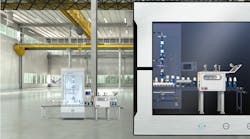Putting future-ready digitization concepts into practice today
It’s no secret that today’s emphasis on data and digitization is opening up a tremendous wealth of opportunities. However, it might not be easy for manufacturers to keep up with the rapid transformations enabled by these technological developments. To stay grounded within a shifting landscape and prepare for the future, it helps to look at common Industry 4.0 themes from a practical standpoint and understand how they can drive manufacturers to make meaningful decisions.
Data can help us do a lot of great things, and by understanding how to capitalize on its value, we can prepare for a future of even more rapid technological change. In this article, we’ll explore some of the most common digitalization concepts and strategies so that you can answer the question “what do we do today?”
Data drives “Smart Factory” ideas that are consistent, purposeful, and not just theoretical
As manufacturers drive towards the goal of Smart Factory, they need to adopt industry trends like IIoT (Industrial Internet of Things), flexible manufacturing, predictive maintenance, and so on. To help understand how these concepts should be driving decisions today, it helps to look at these somewhat abstract trends by looking at the underlying concepts present in all of them, namely data, flexibility and changing labor dynamics.
Manufacturers depend on data to support their business in different ways. For instance, one of the largest concerns for production, due to its sheer costliness, is unplanned downtime. The process of collecting, analyzing, and using data allows manufacturers perform predictive maintenance to prevent unplanned downtime. Similarly, data is used to improve process performance using machine learning by harvesting data, understanding it, and utilizing it to improve production performance and reduce cost.
Seeing flexible manufacturing from two perspectives
Flexibility is a term that we hear a lot, and it can be difficult to define. However, there’s no denying that it’s an important aspect of present-day manufacturing. The idea of dropping a machine onto a plant floor and leave it for 40 years is a thing of the past that’s simply not feasible in this day and age.
It helps to consider flexibility from the perspective of two different time horizons; short term and long term. Short-term flexibility enables mass customization or lot-size-of-one to provide customers products according to their specific liking. This offers significant value to the customer, but it also benefits manufacturers by reducing WIP and surplus inventory.
Flexibility over the short term, however, isn’t enough. We also need an architecture that can support flexibility over the entire lifespan of the equipment. An architecture designed for long-term flexibility should be able to adapt to new technologies as they are introduced to the plant floor. Using an architecture that allows for adaptations as new technologies are introduced is far better for manufacturers than needing to make wholesale changes down the road.
Changing labor dynamics present real challenges
Labor shortage is potentially the most critical challenge that US manufacturers are facing today. There simply are not enough skilled workers available and existing workers are having to cover a wide breadth of job tasks that they can’t complete them all, let alone be trained on new skills. Manufacturers need automation to simplify and replace these tasks so that workers can be freed up to cover more value-added tasks and grow their skillset.
It’s possible to automate the entire manufacturing process from raw material handling all the way to finished goods and into logistics, improving overall equipment effectiveness (OEE) and reducing waste in the process. In the next few sections, we’ll look at three things you can do, starting today, to move forward with a flexible, data-driven manufacturing systems.
The future of manufacturing depends on data, on flexibility, and on changing labor dynamics. Going back to that first question — “what do we do today?” — we can distill three specific pieces of advice: 1) focus on machine performance, 2) develop simple and robust solutions, and 3) collect, analyze and utilize data.
Focusing on machine performance
The first thing to look at is the CPU design approach. Choose controllers that are based on a real-time operating system. This means that you can have deterministic operation that will guarantee that user programs, IO, and communication cycles are executed exactly at a set cycle rate, which is essential to get optimal performance. While some controllers make use of embedded Windows, it’s far better to use an operating system that was specifically designed for real-time, tight control.
On top of this, be sure to use compiled code and avoid interpreted languages. Compiled code creates a machine-executable file that you send down to the controller and to be executed very quickly at runtime. With interpreted languages, you send your code straight down to the CPU after you write it — there’s no compilation step in between. At runtime, another piece of software called an interpreter will then take your program line by line and interpret it in real time, which is significantly slower.
Extending the idea of high performance, having a machine control network that can support real-time deterministic control is also essential. The highest-performing, most deterministic system currently available is EtherCAT, which is easy to work with and incredibly fast. Additionally, by using a deterministic network with deterministic program execution, the machine controller can achieve synchronization between user program, communication devices, and any IO. This makes it so that the data you need to process is there when you need it, and accurate in time.
Building a simple and robust solution
The simplest solution tends to be the best solution. The CPU is the backbone of the whole system. A CPU with advanced out-of-box features has the capability to free up the processor to handle all different type of communication. Even if you don't need the performance from a machine control standpoint, you will be grateful for it because of the communication capabilities that it affords you.
You shouldn’t need to have a version of software for every single version of firmware of TLC that you need to deal with. You only should need one version of IDE to talk to all the different versions of firmware of CPUs that you deal with.
Collecting, analyzing, and using more data
Lastly, always choose more data. For instance, with sensors, select IO-Link enabled sensors for the vast data they provide. This gives you so much more data to have available for future data analysis and machine learning, and there are features specific to IO-Link that make life much easier for the manufacturer long term; serial number and part number verification, auto backup and restore, etc.
We purchase products from Amazon every day because the purchasing process is quick and easy with so many selections. After you place an order, you can track it. You know how long will take it to deliver to you at your selected location and you can see where it is at during the transaction period. By making relevant data accessible, an online retail giant like Amazon builds close connections with its customers.
We can apply the same concept to manufacturing. You can collect as much data as you need, but none of it will bring value if it isn’t accessible. You want to see what is going on with your supply chain. Your assembly line needs to know where parts are going to be, and when they will arrive. The more information that you can access, the better you can control your production process, connecting more strongly with your customers by offering accurate information.
As more data becomes available, there is likely to be plenty of information about an application that you don't see as being critical to process performance. Nonetheless, simply having this data accessible is a huge benefit, since you can always look at it after the fact in the chance that some of it turns out to be applicable after all.
An all-in-one platform is essential to maximizing the amount of information available, and such platforms will continue to evolve to support OEE in the future. One of the benefits of adopting an all-in-one platform is that even if you're not employing artificial intelligence in real time, the platform gives you a time series database function. Using an all-in-one platform, you will be able to add different types of devices and collect data from all of them. At the same time, you can get rid of excess wiring and can just go down to a few Cat5 and Cat6 cables.





